Capitalism and competition are one thing. Government policies and actions are quite another. You already know this.
 Sometimes, however, these two seemingly-opposite concepts aren’t so different. What does this have to do with Light-Sport Aircraft?
Sometimes, however, these two seemingly-opposite concepts aren’t so different. What does this have to do with Light-Sport Aircraft?
American pilots, like aviators in other countries, must obey regulations in the nation where they operate their airplanes. Yet the same requirement is not necessarily true for those who produce the airplanes we enjoy. Producers, it turns out, have choices.
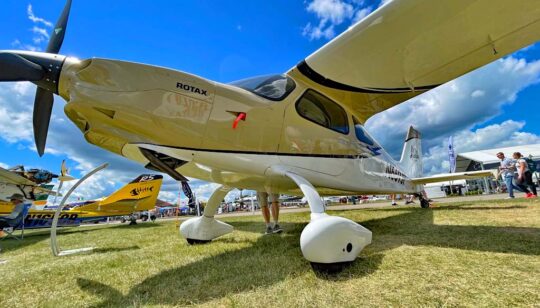
The Airplane Factory’s newly-introduced, cantilevered High Wing seen in taildragger configuration. This larger “Mosaic LSA” has four seat capability.
Under an arrangement called reciprocity, manufacturers in certain nations (Note 1; see at bottom) can meet their local regulations and FAA will then accept such aircraft without them going through the American certification system. What results is a form of competition between government regulatory agencies.
European builders may be early users and beneficiaries but American companies could use reciprocity as well.
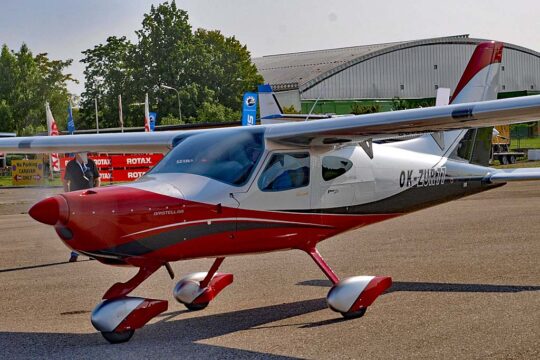
BRM Aero showed their new cantilevered B8 high wing model at the Rotax Fly-in 2021. It debuted to the public at Aero Friedrichshafen 2022.
Readers may remember that when Cessna was still promoting their ill-fated Skycatcher SLSA, they considered pursuing 1990’s-era Primary Category. It is significantly more costly than meeting ASTM standards, but allowed higher weights. Some in the company felt that achieving the more conventional certification might facilitate sales in Europe (Note 2).
If you are thinking that all this makes no difference to you, I get it. Government regulations make for some of the dullest reading imaginable. Yet in today’s thoroughly-regulated environment, a new aircraft cannot fly without the approval of some aviation agency… with one exception: Part 103 or other national equivalents. So, companies learn to comply with government regulatory systems as best they can. If it is easier to gain approval in one country and use that system to make sales in another country, most decision makers will follow the path of least resistance.
Brazil’s ANAC
Most pilots know Brazil is an active aviation state. The South American nation has famous producers like jet-maker Embraer plus numerous LSA producers (Seamax Aircraft, Scoda and their Super Petrel, Montaer).
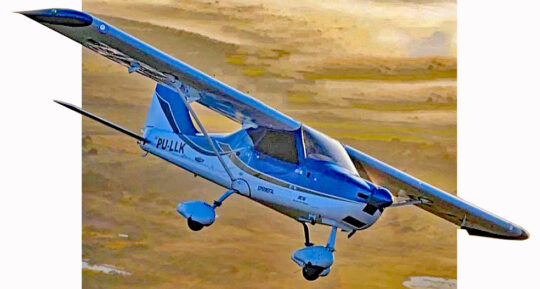
Montaer builds the MC-01, featuring a roomy cabin able to expand into the new regulation.
Many readers may recall that Brazil has embraced Light-Sport Aircraft as a category and accepted ASTM standards in lieu of their own aircraft certification program. Brazil has enjoyed LSA almost as long as America.
As do many countries, Brazil closely observes what FAA does. Yet their regulators can run ahead of FAA when they see a path forward.
In July this year, Brazilian regulatory changes were approved for the expansion of Light-Sport Aircraft in Brazil. “The goal is to allow larger aircraft with other technical characteristics to also enjoy the advantages of this model,” noted Kleber Jesuino, a coordinator for the ANAC’s Department of Airworthiness, in a report to the ASTM F37 committee revising standards for Mosaic. ANAC is the Brazilian counterpart to FAA.
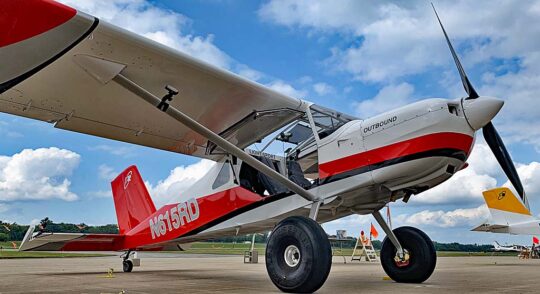
With an 1,800 pound gross weight, Outbound is well positioned to become a Mosaic LSA if the company chooses to pursue it.
“The new regulation, besides bringing Brazil closer to international standards,” said Kleber, “reduces regulatory complexity by allowing airplane with up to four seats and maximum take-off weight of up to 1,361 kilograms (3,000 pounds) to use LSA category consensus standards developed by ASTM International.”
He added that the new rules will reduce costs to get approval for new aircrat designs compared to Part 23-style type certification yet maintain an acceptable level of safety.
“In Brazil, the creation of the LSA category took place in 2010 with the publication of rules for design and manufacture, and the implementation of the rules for operation, maintenance, and instruction occurred in a staggered manner,” clarified Kleber.
Brazil has five domestic LSA models recognized by ANAC and another three in process, he reported.
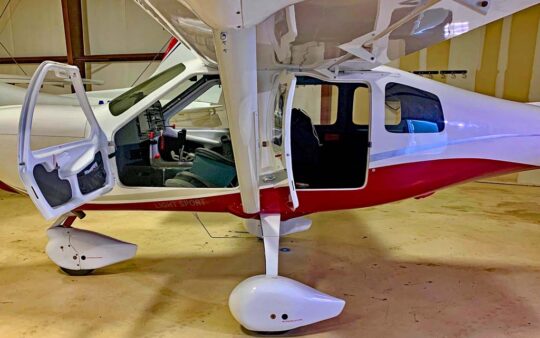
Jabiru is another brand ready for Mosaic LSA. Sold in the USA as the J230, this model is a four seat model in Australia.
Since April 2021, “ANAC worked with national LSA manufacturers in a Joint Study Group to evaluate the current consensus standards accepted for the LSA category with a focus on expanding the regulatory model of this category in Brazil.” Four months later, in August 2021, the study group recommended expanding some technical characteristics in earlier regulations.
The ANAC-lead group issued a survey to assess the public’s view on the proposed changes. They report hundreds of contributions were received.
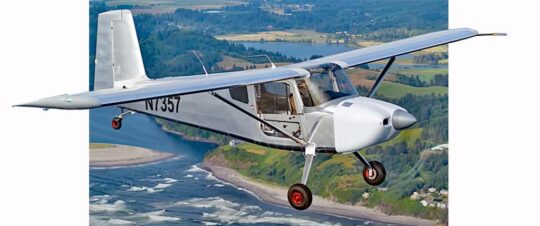
While full information has not yet been stated for Van’s Aircraft’s still-in-prototype RV-15, the size of the aircraft suggests it could be aimed at being a Mosaic LSA.
Kleber finished, “The regulatory changes for LSA in Brazil were treated with priority in the Agency.”
Yes, I guess that’s right. All this was concluded in the space of a few months. In that sense it hardly compares to Mosaic, which has taken years — although FAA’s rule tackled far more, one big chunk of which is now being removed to hasten completion.
Some Good News
Pilots are rather discouraged with FAA right now and that’s understandable. Many have been waiting for the right rules before they buy an airplane.
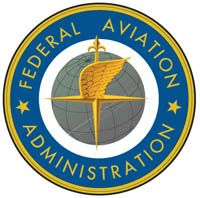
“They are just cutting out the drone stuff,” summarized Roy.
”Mosaic should be wrapped up by the end of 2024,” reported Roy after the meeting. If that happens we could see actual “Mosaic LSA” flying in early 2025.
Across the Pond
In one particularly illuminating meeting at Oshkosh 2022 — toward the end of a lengthy discussion regarding the future of LSA, FAA’s Mosaic program and delays, and other countries preparing regulations — an individual recognized by everyone in the room as someone with rare insight to the highest levels in the agency said, “People are starting to give up on the FAA and turning to EASA for modern and more quickly-expedited approvals.”
So it is good FAA has picked up the pace on Mosaic now that drone regulation will be split out and will proceed on its own parallel track. Let’s keep this in perspective: Mosaic’s year delay is less than we experienced with the SP/LSA rule that was announced three years before it actually happened.
Stay tuned… I will follow this as closely as I can over the next couple years.
LINKS:
- BRM Aero (B8 high wing)
- Jabiru J230 (designed for higher weight)
- Sling High Wing (four seat capability)
- Van’s RV15 project (big and backcountry capable)
- Montaer (designed for higher weight)
- Rans Outbound (video)
- Part 103 and worldwide equivalents (article)
(Note 1) A nation with a bilateral safety agreement with the USA can approve an aircraft according to their (usually rather similar) national regulations and then seek reciprocity for their CAA’s approval to be honored by FAA. This is well established. Countries seeking a BSA with the USA go through a lengthy, up to seven-year, process to assure regulatory systems are roughly in sync.
(Note 2) One of the reasons why Cessna may have sought extra weight was because their LSA entry had a confiningly-low payload. As designed, it was not optimal for flight schools. Weight exemptions — such as later won by Icon, TerraFugia, SkyRunner, and Vickers — had not gained approval when Cessna made their Primary Category decisions.


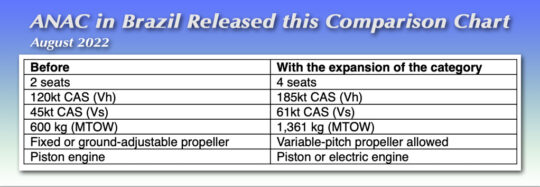
At the rate we are going we’re gonna have issues on the maintenance side because largely the FAA has not addressed this in the NPRM. I suspect they want to try and fix an issue that’s not broken. The main reason owners of aircraft takes the course because their local A&P’s don’t know how to maintain this new breed of aircraft or that they need an LOA to change things from the manufacturers. If we keep this up we’re gonna have $125K paperweights that won’t be able to fly because the wait times for inspections will be ridiculous. Finding an A&P that knows the LSA platforms well enough to maintain them properly is few and far between. They should address the EAB issues as well when the same aircraft platform in some cases needs an A&P if amateur built or an LSRM if an S/E-LSA. There is still alot of work to do and I hope the ASTM helps direct the maintenance side because nobody knows what is gonna happen when MOSAIC hits. It’s either gonna not address the maintenance or it’s gonna make the rules confusing or impossible to comply making existing LSRM’s job that much harder than it is today. Keeping things vague did not work for the recreational certificate so I’m hoping they don’t take a step backwards and revisit the same mistakes of the past. If you don’t have people that can maintain effectively and safely then new aircraft won’t be sold because it’ll be impossible to get adequate and safe maintenance performed without delays or exorbitant cost.
All you guys in America are lucky you even have FAA FAR Part 103, we in Australia don’t even have that category of Aviation, nor are we likely to ever likely to
get it. 🙁
2025. Just F-ing wow. What a bunch of bureaucrats we have at FAA.
Thanks Dan for promoting the work done by Brazil!
Likewise, Kleber, thanks for your work on the ASTM committee.
I would think Beech, Cessna, Piper, and other U.S. Part 23 manufacturers would be frothing at the mouth to get this MOSAIC mess settled. Imagine how much development money could be saved if Beech came out with a new 4-seater about the size and performance of the Sundowner or Sierra using the ASTM process for “Special” aircraft. I wonder why there hasn’t been more interest shown by the major piston engine manufacturers.
Have you ever thought it might be the other way around? Part 23 manufacturers may be interested in delaying MOSAIC to keep market competition at the current low level. They are already in the game. Why would they fight to remove the “moats” and reduce their own margins?
Separating the drone issue is bad news. That means they will render a judgement that will abrogate pilots’ concerns at large.
To those who want a simpler system, ask yourself if the lawyers make as much in the EU as they do here?
Let’s not forget kite flying.
I believe we need non-conductive string as a safety measure.
I believe your last report card from the sixth grade should make you qualified to be able to fly a kite with or without a tail.
Thank you for your update. The elephant in the room is to me, is the medical. Really all the FAA needs to do is to apply the LSA Drivers license medical to private pilots, done.
Exactly. This is what I’d hoped for with Basic Med. It’s not that I’m not healthy enough to get a medical. It’s that I did something dumb 24 years ago, and in the words of one of the FAA’s own doctors, it would be “possible” for me to get a medical, but it would be “highly unlikely” and it would be “expensive” to find out. And then if I didn’t get it I could not fly Sport Pilot. What did I do? I attempted suicide. Young, stupid, and did something that would forever put a checkbox on the paper. I’m not mentally ill, and I live a great life, but was in a rough place at the time and did something incredibly dumb.
I’ve been told I might be able to get a 3rd class, but it would be costly and risky. What if I fail, IMO due to outmodes government regs? No more Sport, grounded for life, so I cannot take the chance.
Never happen it’s their bread and butter if they lost class 3 medicals they would have to reduce their budget by 2/3rds they will never do that. Only way I ever see that happening is congress acts which needs to happen. If the industry wants to make real change they should put their efforts into congress removing the class 3 medical and forget about mosaic.
Two-thirds of the FAA budget is devoted to 3rd class medical??
You are correct. Thanks for highlighting this importance of this.
Thank You Dan for the info, I love reading your articles and met you last year at Oshkosh. You do a excellent job keeping us informed. I have been wondering what happened to the MOSAIC. I expected the FAA to come out with something at Oshkosh. Like the rest of our government today the FAA clearly dropped the ball AGAIN. I guess they are getting paid and in no hurry to get it done. I have been anxiously waiting for the new rules to come out.
Did I miss something? THE issue that’s made LSA aircraft popular is there’s no Class III FAA medical exam required. I didn’t see that mentioned if it may apply to the NEW LSA rules???
You didn’t see anything because we are hearing little from the FAA group called Flight Standards that will deal with the pilot privileges — including the medical aspect — and operational regulations. Most of what we know has come from the aircraft certification side so that’s what I can report.
However, at Oshkosh 2022, several FAA personnel stated that the idea in Mosaic is to expand the privileges of Sport Pilot, not restrict them. No one mentioned any decline in the use of a driver’s license in lieu of an aviation medical. Those statements represent only a few kernels of information but I take them as a positive.
Problem is that once you lose/fail your Class 3 you can’t use BasicMed. You need to get the Class 3 back them you can use BasicMed later.
I’m confused. If another country gets an aircraft certified as a LSA under their rules and their rules allow LSAs to be heavier, faster and carry more people does that mean they can get the FAA to recognize that as a LSA that can be flown by Sport Pilots in the USA? I suspect not but that seems to be what this article is implying.
Your conclusion is correct. No producer can gain approval as a U.S. LSA if it exceeds the present parameters.
What is happening is that manufacturers are using foreign certification systems to prepare for Mosaic faster. FAA will not issue an NPRM before about this time next year and then they say they need 16 months to receive comments, make changes, and issue a final rule. That translates to not having a final rule until the end of 2024 so the first aircraft will not emerge as FAA-accepted LSA until early 2025.
However, since Brazil and Europe — and other countries under earlier regulations — already have higher weights and speeds, etc., they can go forward with designs that work for those parameters and they will then be well positioned with aircraft in production at (approximately) Mosaic parameters. This will give them a leg up to make early sales of Mosaic LSA.
I hope that help clarified it somewhat.
Ok, I’m confused. The article says, “FAA said the regulation text is being actively worked on and should be finished by September.” And here you’ve said that they won’t issue an NPRM before this time next year. I thought that the next thing after the rules being finished would be the NPRM. Why wait until next year?
FAA is working on the present form of the regulation to remove all references to drones (meaning uncrewed aircraft). That part of the work effort is what will be done by this September. Then, rule writers can complete work on the Mosaic rule without drones, which should make the effort go faster. Trying to fully incorporate drones, as the present-day Mosaic draft attempted, would have significantly slowed issuance of Mosaic for the rest of us non-drones. Although we are delayed a year — at least Mosaic for LSA, kit-built, warbirds and other Special Airworthiness certificate holders can now be completed without worrying over progress on the drone side (which has been going slower).
Ok – that makes sense. Thanks for the explanation.
While the Sport Pilot portion of the regs mean more to me, as I’m looking forward to becoming a pilot and want to fly heavier craft (I’m not the lightest guy), I do also have some interest in the uncrewed portion, since I have my Remote Pilot Certificate. That’s not as important to me, though, because while I do fly the drone a bit recreationally, it’s not my living.
Nice article, Dan!
Thanks for the update, Dan. I appreciate your dedication to finding and sharing the info on the subject. You do a great job, and I believe are hands-down the best source of information out there when it comes to SP/LSA.
That’s very kind of you to say.
The FAA is not regulating LSA.
They are regulating PILOTS!
It has seemed that eastern European teams have become the test bed for light aircraft. The lead in the area the U.S. used to have has been replaced by groups of clever talented aeronautical engineers.
The United States hasn’t led dick squat in the general aviation/light aircraft market since the 1950s. All of the modern designs for the last two decades are more are coming out of Europe.
Match the EU. KISS
Exactly! No limits on speed, retractable gear, speed nor constant speed prop and make weight 2,000 pounds max take off weight!